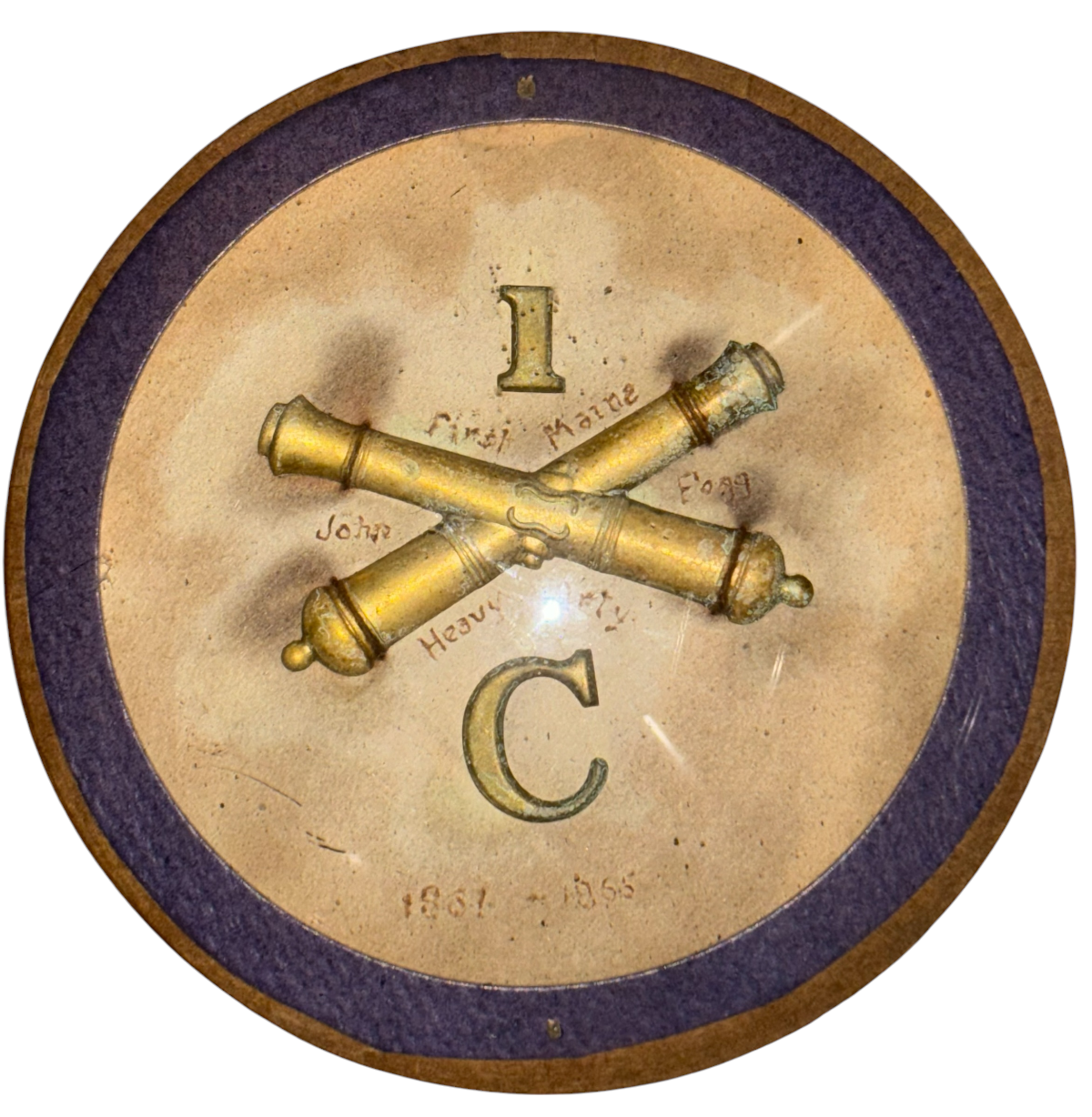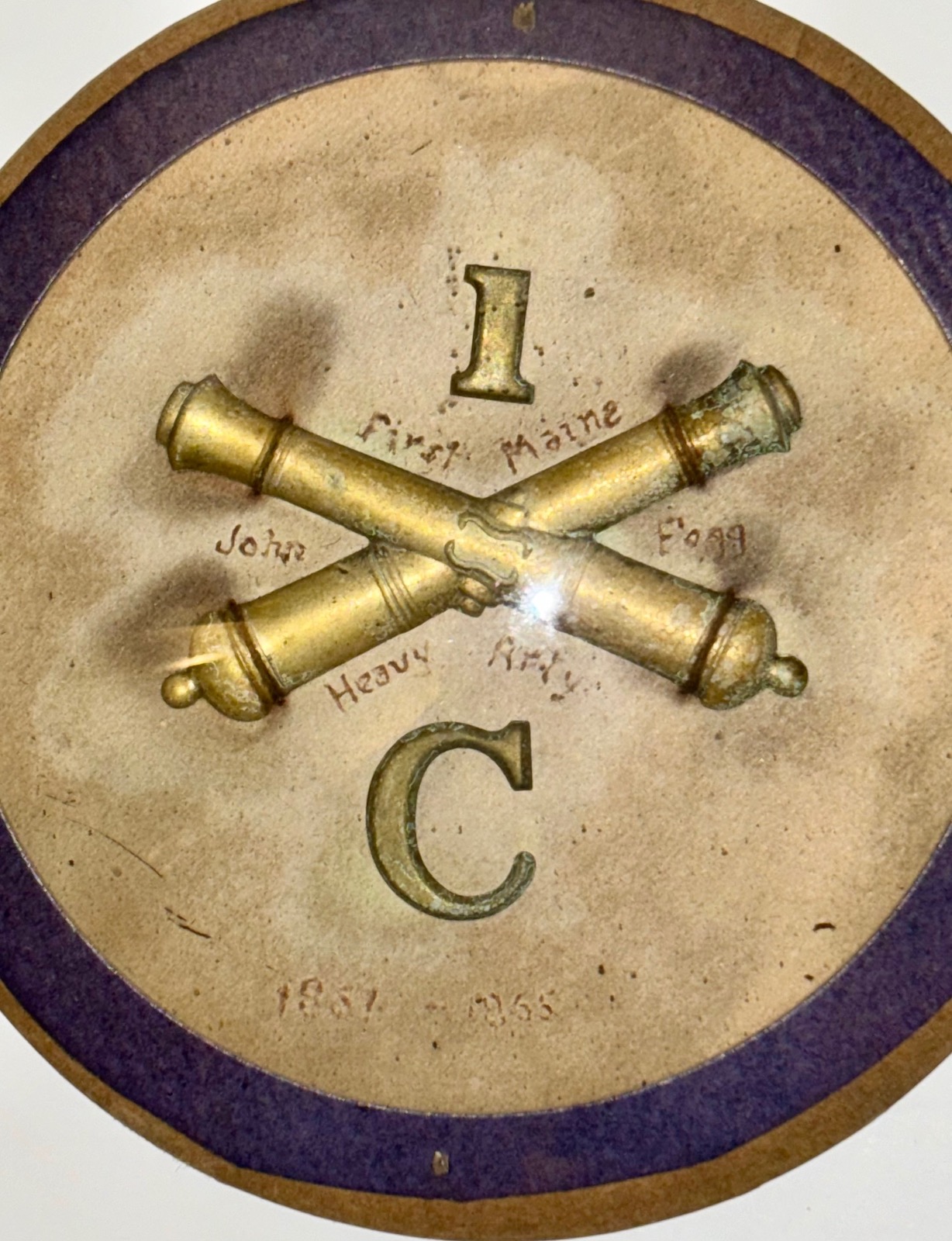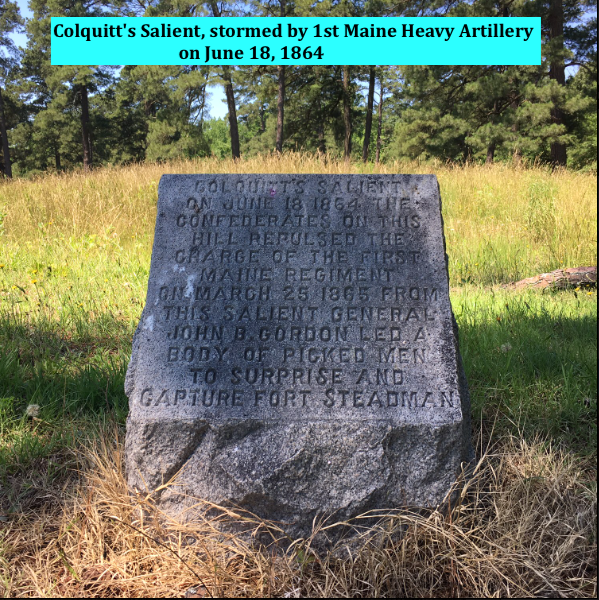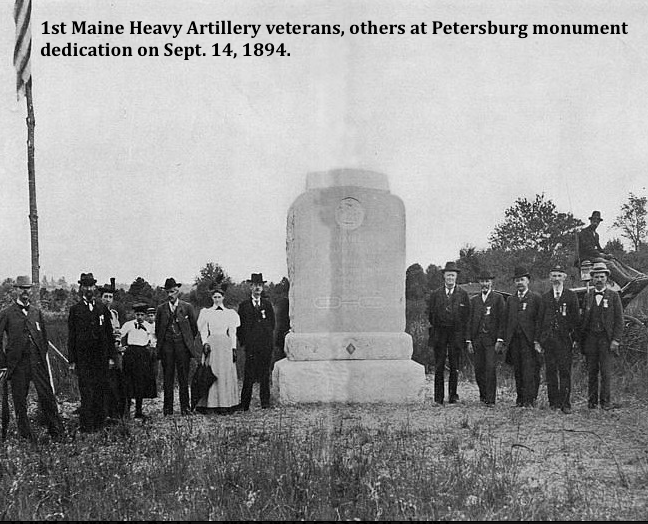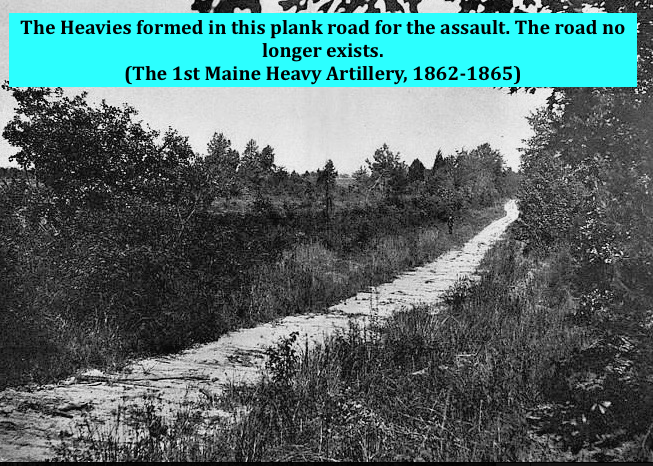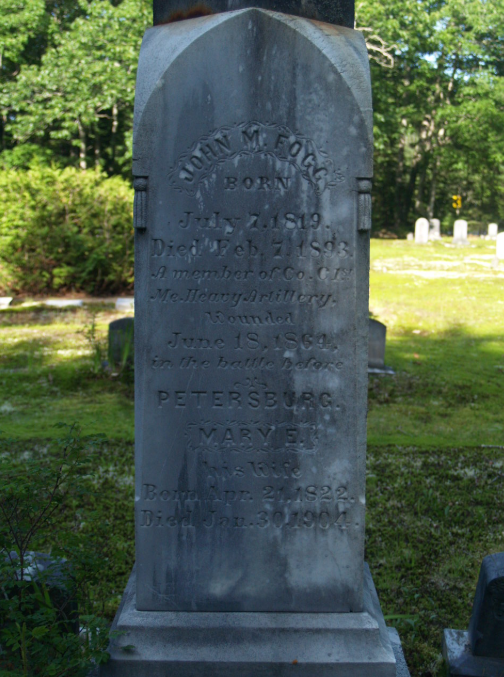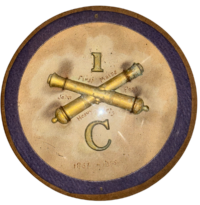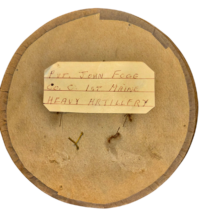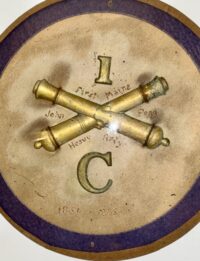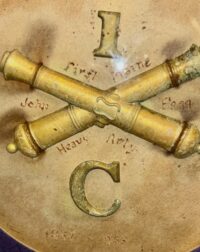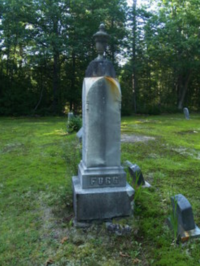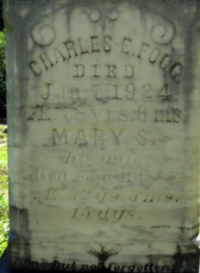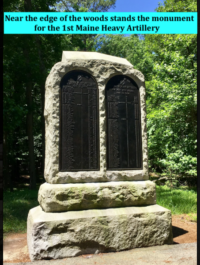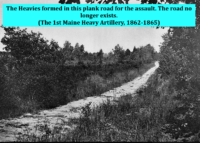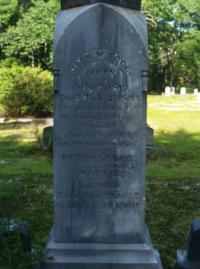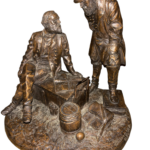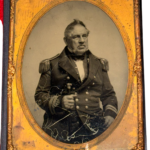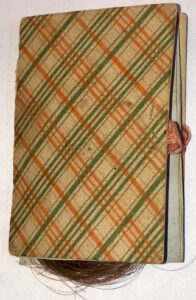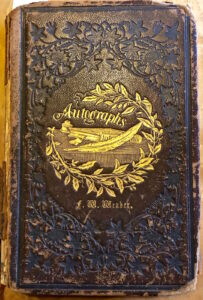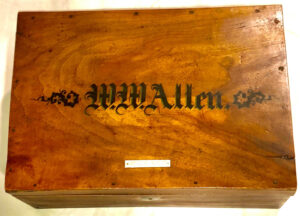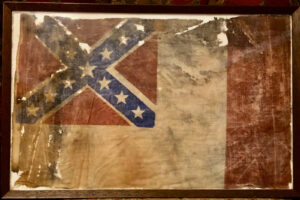Id’d Cap Insignia Grouping Attached to Old Pasteboard – Private John C. Fogg Co. C 1st Maine Heavy Artillery
SOLD
Id’d Cap Insignia Grouping Attached to Old Pasteboard – Private John C. Fogg Co. C 1st Maine Heavy Artillery – This grouping of cap insignia includes an enlisted man’s artillery, crossed cannons; a company “C”; the regimental number “1”. These insignia are attached, via old wire and by their original hat attachment wires, to a circular piece of old pasteboard or cardboard – it is conceivable that this stiff paper may have comprised the crown of Private Fogg’s cap. Surrounding the crossed cannon insignia, written in period ink, is the following:
“First Maine
John Fogg
Heavy Arty
1861 – 1865”
John Fogg was a 44-year-old farmer, living in Mariaville, Maine when he enlisted in the Union Army into Co. C of the 1st Maine Heavy Artillery, on December 1, 1863. The 1st Maine was initially deployed in forts surrounding Washington, DC, but with the inception of the Overland Campaign, with the Union Army in need of additional troops, the Maine Heavies were moved to Belle Plain, in preparation to deploy south. Shortly thereafter, the regiment’s troops became active participants, as infantrymen without previous training or combat experience, in the grueling Overland Campaign engagements at the North Anna River, Cold Harbor, Totopotomoy Creek, then participating in the opening salvos of the Siege of Petersburg; on June 18, 1864 the regiment was sent on an assault on the Confederate works at Colquitt’s Salient, just 100 yards, northwest of Ft. Stedman. In this ill-advised attack, the 1st Maine Heavy Artillery sustained the greatest loss of any one Regiment in any one action of the war – 685 killed and wounded out of 900 engaged, in less than 20 minutes. Although suffering horrific losses on June 18, the regiment would participate throughout the rest of the war – engaged during the remainder of the Siege of Petersburg, at Deep Bottom, the Boydton Plank Road, Hatcher’s Run, as well as during the pursuit of Lee’s Army of Northern Virginia, at Amelia Springs, Sailor’s Creek and finally Appomattox.
Private Fogg was amongst the many 1st Maine Heavy Artillery soldiers wounded during the charge of June 18, 1864, although he would survive and ultimately return to his home town in Maine.
All three insignia elements exhibit some effects of outside weather exposure, but remain in overall excellent condition. The pasteboard or cardboard exhibits some foxing, but is strong and not deteriorated. The inked identification of the regiment and Private Fogg’s name is readily readable, although the ink does exhibit some fading. The board with insignia has been housed beneath a dome of plastic, affixed to the board via some form of tape; within the dome is a blue mat, surrounding the group of insignia. This group of insignia represents the heroic actions of a brave regiment who suffered incredible losses in a frighteningly short period of time.
Measurement: Diameter of board – 6.5”
John M. Fogg
| Residence Mariaville ME; 44 years old.
Enlisted on 12/1/1863 as a Private. On 12/1/1863 he mustered into “C” Co. ME 1st Heavy Artillery He was Mustered Out on 9/1/1866 He was listed as: * Wounded 6/18/1864 Petersburg, VA (Absent) Other Information: died in 1893
|
||||||||||||||||||||||||||||||||||||||||||||||||||||
| Spouse | Mary Elizabeth (Fogg) Fiske |
| Father | Jonathan B Fogg |
| Mother | Pheobe Curtis (Fogg) Waterhouse |
| Children | Willard Orman |
| Birth | 7 Jul 1818 Scarborough, Cumberland, Maine, USA |
| Death | 7 Feb 1893 Otis, Hancock, Maine, USA |
| Residence | 1 July 1863 Otis, Hancock, Maine, USA
John M. Fogg |
| Spouse | Mary Elizabeth (Fogg) Fiske |
| Father | Jonathan B Fogg |
| Mother | Pheobe Curtis (Fogg) Waterhouse |
| Children | Willard Orman |
| Birth | 7 Jul 1818 Scarborough, Cumberland, Maine, USA |
| Death | 7 Feb 1893 Otis, Hancock, Maine, USA |
| Residence | 1 July 1863 Otis, Hancock, Maine, USA |
1st ME Heavy Artillery
( 3-years )
| Organized: on 8/1/62 Mustered Out: 9/11/65Officers Killed or Mortally Wounded: 23 Officers Died of Disease, Accidents, etc.: 2 Enlisted Men Killed or Mortally Wounded: 400 Enlisted Men Died of Disease, Accidents, etc.: 258 (Source: Fox, Regimental Losses) |
| From | To | Brigade | Division | Corps | Army | Comment |
| Aug ’62 | Oct ’62 | Artillery | Defenses North of Potomac | Whipple’s Command | Military District of Washington | New Organization |
| Oct ’62 | Feb ’63 | 1 | Defenses North of Potomac | Whipple’s Command | Military District of Washington | |
| Feb ’63 | May ’64 | 2 | Defenses North of Potomac | 22 | Department of Washington, D.C. | |
| Mar ’63 | Jun ’63 | 1 | Defenses North of Potomac | 22 | Department of Washington, D.C. | Co. M |
| May ’64 | May ’64 | Artillery | Tyler’s HA | 2 | Army of Potomac | |
| May ’64 | Jul ’64 | 3 | 3 | 2 | Army of Potomac | |
| Jul ’64 | Jun ’65 | 1 | 3 | 2 | Army of Potomac |
MAINE
1ST HEAVY ARTILLERY
(three years)
|
First Heavy Artillery.-Cols., Daniel Chaplin, Russell B. Shepherd; Lieut.-Cols., Thomas H. Talbot, Russell B. Shepherd, Zemro A. Smith; Majs., Charles Hamlin, Russell B. Shepherd, George W. Sabine, Christopher V. Crossman, Zemro A. Smith, Charles W. Nute, Harrison G. Smith. This regiment was originally organized as the 18th infantry (q.v.), but was changed to heavy artillery after five months’ service, and by general order No. 62, from the adjutant-general’s office of Maine, series of 1862, was designated as the 1st regiment, heavy artillery, Maine volunteers. Two additional companies were organized-one in Jan., 1864, the other in Feb., 1864. The original members were mustered out on June 6, 1865, but the organization, composed of veterans and recruits of this regiment and accessions from the 17th and 19th Me. infantry, remained in service and was mustered out at Washington, D. C., Sept. 11, 1865. The men returned to Bangor, Me., on the 17th and were paid and discharged on the 20th. The several companies were stationed in the defenses of Washington until 1864. The 3d battery of mounted artillery was temporarily attached to this regiment, and served as Co. M, from March 28, 1863, to Feb. 23, 1864 The maximum number of men required for the regiment (1,800), was secured in Feb., 1864, when two new majors were added and four lieutenants in each company instead of two. On May 15, 1864, the regiment as thus organized joined the Army of the Potomac at Belle Plain landing and came under fire for the first time on the 19th, when it took a prominent part in repulsing a heavy attack of the enemy on the supply trains near the Fredericksburg pike. It suffered severely in the action, losing 476 men in killed, wounded and missing. It subsequently participated in the battles of Totopotomy, Cold Harbor, Petersburg, Deep Bottom, Boydton road, Weldon railroad, Hatcher’s run, and in all the final movements resulting in the evacuation of Richmond and Petersburg and the surrender of Gen. Lee. On May 24, 1864, the regiment was assigned to the 3d brigade, 3d division, 2nd corps. In the heroic assaults on the enemy’s works at Petersburg, between June 15-30, the regiment lost 30 killed, 519 wounded and 31 missing, 6 of the killed being commissioned officers. Col. Chaplin was mortally wounded by a sharpshooter on Aug. 18 at Deep Bottom, and in the action on the Boydton plank road, Oct. 27, the regiment lost 3 commissioned officers and 29 men. In an engagement of a little more than an hour at Hatcher’s run, March 25, 1865 it lost 1 officer and 3 men killed, and 23 wounded and captured. The regiment was at Bailey’s cross-roads April 16, and later participated in the grand review at Washington. |
1st Regiment, Maine Heavy Artillery
Overview:
Organized at Bangor as 18th Infantry and mustered in August 21, 1862. Left State for Washington, D. C., August 24. Designation changed to 1st Heavy Artillery January 6, 1863. Company “L” organized January, 1864, and Company “M” February, 1864. Attached to Defenses of Washington, August, 1862, to February, 1863. 2nd Brigade, Haskins’ Division, 22nd Army Corps. Defenses North of the Potomac to May, 1864. 2nd Brigade, 4th Division, 2nd Army Corps, Army of the Potomac, to May 24, 1864. 1st Brigade, 3rd Division, 2nd Army Corps, to July, 1864. 2nd Brigade, 3rd Division, 2nd Army Corps, to June, 1865. 3rd Brigade, Hardin’s Division, 22nd Corps, to September, 1865.
SERVICE-Duty in the Defenses of Washington, building and garrisoning Batteries and Forts. Eight Companies at Fort Alexandria, Company “E” at Batteries Vermont and Mattox, Company “K” at Batteries Cameron and Parrott, August 26, 2862, to May 15, 1864. Moved to Belle Plains, Va., May 15, 1864, as a part of Tyler’s Heavy Artillery Division. Rapidan Campaign May 18 to June 15. Harris’ Farm, Fredericksburg Road, May 19. (82 killed, 394 wounded, 5 missing; total 481.) On line of North Anna May 20-23. North Anna May 23-26. On line of the Pamunkey River May 26-28. Totopotomoy May 28-31. Cold Harbor June 1-5. Barker’s Mills June 5-12. Before Petersburg June 16-19. Hare’s House, Assault on Petersburg, June 18. (Sustained greatest loss of any one Regiment in any one action of the war. 685 killed and wounded out of 900 engaged.) Siege of Petersburg June 16, 1864, to April 2, 1865. Weldon Railroad June 22-23, 1864. Picket duty at Deserted House till July 28. Demonstration on north side of James River July 27-29. Deep Bottom July 27-28. Duty at Hare’s House till August 12. Demonstration on north side of James River August 13-20. Strawberry Plains August 14-18. Near Fort Sedgwick till September 30. Poplar Springs Church September 30-October 2. Yellow House October 1. Squirrel Level Road October 2. At Fort Sedgwick October 6-24. Boydton Plank Road, Hatcher’s Run, October 27-28. Warren’s Hicksford Raid December 7-12. Hatcher’s Run February 5-7, 1865. Armstrong House March 25. Appomattox Campaign March 28-April 9. South Side Railroad March 29. Boydton Road and White Oak Ridge March 29-31. Fall of Petersburg April 2. Jettersville April 5. Amelia Springs and Sailor’s Creek April 6. Farmville April 7. Appomattox Court House April 9. Surrender of Lee and his army. Moved to Washington, D. C., May 9-16. Grand Review May 23. Garrison Forts in the Defences of Washington from Fort Washington to Fort Mahone June 27 to September 11. Mustered out September 11 and ordered to Bangor, Me. Discharged September 20, 1865.
Of all Regiments in army this Regiment sustained greatest loss in battle. 23 Officers and 400 Enlisted men killed and mortally wounded; 260 died of disease, etc. Total 683.
The 1st Maine Heavy Artillery Regiment was a regiment in the Union Army during the American Civil War. It suffered more casualties in an ill-fated charge during the Second Battle of Petersburg than any Union regiment lost in a single day of combat throughout the war. It was also the Union regiment with the highest number of officers killed (23).[1]
The regiment was mustered in Bangor, Maine, in 1862 as the 18th Maine Volunteer Infantry Regiment and consisted mostly of men and officers from the Penobscot River Valley (the area around Bangor and points east). It was commanded by Col. Daniel Chaplin, a Bangor merchant. Charles Hamlin, son of Vice President Hannibal Hamlin, was originally an officer in this regiment, but was promoted to a position on the staff of Maj. Gen. Hiram G. Berry before it saw significant action.[citation needed]
The regiment’s name was changed in 1863 to the 1st Maine Heavy Artillery Regiment, and it served in the defenses of Washington, D.C. before being reassigned to the Army of the Potomac during the Overland Campaign in the spring of 1864. At the Battle of Spotsylvania Court House, the regiment took its first heavy casualties—6 officers and 76 men killed, and another 6 officers and 388 men wounded. At the Second Battle of Petersburg, however, an ill-advised charge across an open field toward Confederate breastworks on June 18, 1864, ordered by Chaplin, resulted in the greatest single loss of life in a Union regiment to occur in the war, with 7 officers and 108 men killed, and another 25 officers and 464 men wounded. These casualties constituted 67% of the strength of the 900-man force. Chaplin survived the action but was later killed by a sharpshooter.[2] The regiment was commanded by Russell Benjamin Shepherd for the remainder of the war.
All in all, the 1st Maine sustained one of the highest casualty rates in the war, with 423 killed, and another 260 died of disease.[3] A monument to the 1st Maine stands on the former battlefield at Petersburg.
The following is from JOHN BANKS’ CIVIL WAR BLOG:
‘It was folly’: Maine regiment’s disastrous charge at Petersburg
| Near the edge of the woods stands the monument for the 1st Maine Heavy Artillery. |
“Nine hundred men from Maine were we,
As brave and true,
As hot to do,
As any ever wore the blue.
Nine hundred men from Maine!
Where shall their like be found again?”
— The Charge of the Nine Hundred, unknown author, The First Maine Heavy Artillery, 1862-1865, published 1903.
Of all the Civil War battlefield monuments for individual regiments perhaps none tell as stunning a story as the tall, granite monument for the 1st Maine Heavy Artillery at Petersburg, Va. Two large, bronze tablets — one listing mortally wounded, the other those killed outright — honor the 241 soldiers who didn’t survive the futile charge against Confederate works on June 18, 1864. In all, the regiment of nearly 900 soldiers suffered 632 casualties in about 10 to 20 minutes in the attack on Colquitt’s Salient — the greatest number of losses of any regiment in any single day of battle during the war. All the death and maiming occurred in a little more than an acre.
In a post-war account, 1st Maine Heavy Artillery officer Horace Shaw described the prelude to the attack:
“The First Maine had been designated as the center or storming column. They were posted in a portion of the old Prince George Courthouse road, where that road made a sharp turn to the right, running northwest past old New Market Race Course and nearly parallel with the enemy’s line of works, and about five hundred yards distant from them. At this point this road, partly a plank road [above], was dug into the ground, the dirt thrown up at the sides (a common method of making roads in Virginia), the embankments being covered with small trees and bushes a portion of the way, thus affording a good shelter from bullets and shell during the period of waiting for orders.”
SOURCE: Shaw, Horace H. and House, Charles J., The First Maine Heavy Artillery, 1862-1865, Portland, Maine, 1903.
“I SAW THE BLINDING FLASH OF RED FLAME”
Nearly 30 years after the battle, Joel Brown, a private in Company I of the 1st Maine Heavy Artillery, wrote a searing, and eloquent, account of the charge:
“As we scrambled up out of the road, what a sight was before us: about ten or fifteen hundred yards away, across an open field having a little rise and covered with old corn stubble, were the rebel works, bristling with artillery, still as death, awaiting our onslaught. We had become somewhat broken in climbing up out of the road and the sight before us, together with a few stray shots from the sharpshooters along our front, did not tend to steady the line, so our old colonel [Daniel Chaplin], who was I believe, the coolest man that it would be possible to find, gave the command to halt, took his station as on dress parade, ordered his guides on a line, dressed up the regiment, and then put us through the manual of arms as quietly as though we were still in the defences of Washington, and all the while the bullets from the sharpshooters humming about his ears like bees.
“Then came the word, ‘Forward, Double Quick, Charge,’ and with a wild cheer which seemed to me more like the bitter cry wrung out in a death agony, we sprang forward. I saw the works plainly before me. I saw the blinding flash of red flame run along the crest of those works and heard the deafening crash as the awful work began; then the air seemed filled with all the sounds it was possible for it to contain, the hiss of the deadly minie, the scream of the shell, the crackle, crash and roar of every conceivable missile, and through it all that red blaze along the crest of that work which we must cross, as we, with bowed heads, breasted that storm.”
SOURCE: “The Charge of the Heavy Artillery” by Joel Brown, The Maine Bugle, April 1894.
“IT WAS FOLLY”
In a post-war account, George Washburn, a private in the 108th New York, described how veteran regiments huddled for cover rather than join the attack with the Maine Heavies against the well-entrenched Confederates at Colquitt’s Salient.
“While engaged in the frequent fierce contests about Petersburg, our Brigade, which was lying upon I think the Jerusalem road screening themselves as much as possible from rebel sharpshooters, were ordered to support the 1st Maine Heavy Artillery in a charge. The charge was to be made across or into a large field of corn beyond which was a rising eminence and on the left of the field was a wooded acclivity.
“So experienced were the old veterans in such matters in espying masked batteries and concealed musketry that the deadly issue was easily noticed by them, and General [Thomas] Smyth remarked that it was folly for the old boys to be sacrificed in such a place, but as orders must be obeyed, ‘Fall in and we ll do our duty.’ The Maine’s being in line started into the field, the corn being three or four feet in height, and with a ringing shout advanced double quick, and when within the range, the rebels desired a terrible fire from masked batteries and infantry swept through the Maine’s line. Our Brigade in support, the 108th being on the left, dropped at once upon the ground face downward, by so doing the furious storm of shot passed over them. It was their only salvation.”
SOURCE: Washburn, George H. A Complete Military History and Record of 108th Regt. N.Y. Vols., from 1862 to 1894, Rochester, N.Y., 1894.
“EXCEPT AT COLD HARBOR I NEVER SAW SUCH SLAUGHTER”
An unknown Confederate veteran wrote of the attack by “Lincoln’s pets” in this post-war account:
“…Then … Lincoln’s pets, 1,950 strong [sic], the Maine battery charged us and went back with 250. I can realize that this was so, for except at Cold Harbor I never saw such slaughter …”
“… In one of these charges while the shells were flying, I peeped up to see the approaching Federals. Just in front of me there suddenly appeared something like a black, buzzing bee. It was a shell. I knew what it was and down I ducked behind the breastwork. The shell burst in the breastwork right in front of me and covered me with dirt all to my protruding legs. I was pulled out and my head bandaged where a piece of the shell had struck me. It was my duty to report the casualties. I did not report myself. How is this, asked Major Rion? I told him it was slight and I did not want my wife to be unnecessarily alarmed. ‘Wounds, sir. are honorable to a soldier and his command. A wound is any blood letting. Don t let this occur again.’ I told him, ‘I hoped it would not.’ “
SOURCE: Charleston (S.C.) Sunday News, July 25, 1897.
“THE OLD HERO … CRIED LIKE A CHILD”
Like General George Pickett at Gettysburg, the 1st Maine Heavy Artillery’s colonel was shattered by his losses. Here is Private Joel Brown’s heart-rending, post-war account:
“History says that Gen. [David] Birney massed the Second Corps and made a desperate charge that day. So he did, but it was the First Maine Heavy Artillery that made the charge alone. The rest of the corps never crossed the sunken road. I went up the road towards the left to where the colonel [Daniel Chaplin] was, just as Gen. Birney rode up, and heard him say, ‘Col. Chaplin, where are your men?’ and I shall never forget his answer: ‘There they are, out on that field where your tried veterans dared not go. Here, you can take my sword; I have no use for it now;’ and the old hero sat down in the road and cried like a child.
“Just as night began to close in, the adjutant came along and told us to get together and call the roll. We did. Company I got together; we had gone in with seventy-five men; six privates had come out. There was no roll call in that company that night; one of our number wrote the names on a piece of paper and with tears running down his cheeks handed it to the adjutant; that was all. Out of the nine hundred men of the regiment about seven hundred had fallen. Late that night Lieut. Sam Oakes came to us. He had been knocked senseless on the field, but at night revived and crawled off. How we hugged him and cried over him! His coming saved our company from being wiped out, but the bruises he got that day cost him his life within one short year. Our colonel was broken hearted over his loss and threw his life away at Deep Bottom soon after. He seemed not to care to live after his regiment was gone.”
SOURCE: “The Charge of the Heavy Artillery” by Joel Brown, The Maine Bugle, April 1894.
“GHASTLY EVIDENCE OF THE INHUMANITY OF MAN TO MAN!”
A post-war account from Horace Shaw, an officer in Company F of the 1st Maine Heavies:
“In the gray dawn of the morning of the 19th the writer [Horace Shaw], accompanied by comrades [James] Dole and [Ephraim] Drew of Company F, attempted to rescue Lieutenant [Gardner] Ruggles and some other comrades, who were believed to be wounded not far from the enemy’s lines. Taking advantage of the dense fog, they approached to where he was supposed to have fallen, within one hundred yards of the enemy’s breastworks and not far from where the monument [above] now stands. The fog suddenly lifted, they were discovered by the enemy and fire blazed from their guns. They were obliged to drop into the field gullies where the dead were piled and to make a most perilous run to the cover of the breastworks, when the fog again shut down.
“So terrible was the fire for days at this point that no further attempt was made, either to bring any off or to bury the dead, except in the darkness of the night. It was an appalling sight, to take a desperate chance for life and peer over the breastworks across this field of slaughter, strewn thick with the blue-coated bodies of those sterling sons of Maine, decomposing in the fierce rays of a Southern sun. What ghastly evidence of the inhumanity of man to man!”
SOURCE: Shaw, Horace H. and House, Charles J., The First Maine Heavy Artillery, 1862-1865, Portland, Maine, 1903.
“THE CHARGE OF YOUR OWN PICKETT … WAS NO LESS BRILLIANT”
On Sept. 14, 1894, Horace Shaw, author of the Maine Heavies’ regimental history, addressed a gathering of veterans at the dedication of the monument to the regiment at Petersburg. Confederate vets also were present.
“I find myself oppressed with conflicting sentiments of sorrow and gladness, of confidence and fear. We come to this spot sacred to us to dedicate this simple stone which tells of the great sacrifice our comrades made here. The only sentiment upon the stone is in our motto of three links binding Maine and Virginia together in union and peace. This is expressive of our sincere desire. We come from distant states to honor and perpetuate the memory of dead who gave their lives and poured their blood out here. We cannot honor them without expressing our admiration for courage and soldierly qualities of those opposed to us here. The unsuccessful assault is always a fatal one. The charge of your own Pickett at Gettysburg was no less brilliant because unsuccessful. We cannot come here to honor our own loyal dead without paying tribute to the courage of [John] Gordon’s men, who made a gallant, though unsuccessful, charge over the same ground on the following 25th of March. This ground is the more sacred to us because the blood of your sons mingled with ours, has made this spot sacred to you.”
SOURCE: Petersburg (Va.) Index Appeal, Sept. 15, 1894.

